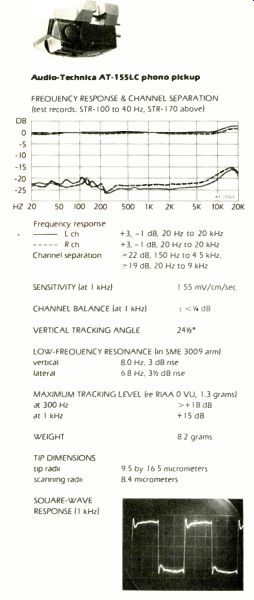
Top Pickup from Audio-Technica
Audio-Technica AT-155LC phono pickup
Audio-Technica AT-155LC fixed-coil phono pickup, with multi-radial diamond stylus. Price: $225; ATN-155LC replacement stylus, $100. Warranty: "limited," one year parts and labor, excluding stylus wear. Manufacturer: Audio-Technica, Japan; U.S. distributor: Audio-Technica U.S., Inc., 1221 Commerce Dr., Stow, Ohio 44224. USA.
The AT-155LC could well be termed the top model in Audio-Technica's "regular" line of five pickups. One model is claimed to overreach it in performance, but more cost-effective production techniques are said to make the 155LC a close runner-up. A fixed-coil design, the pickup employs dual miniature magnets attached directly at the rear of a pure beryllium cantilever. The generating system mates pole pieces to the yoke assembly-what Audio-Technica calls a "para-toroidal" design--to keep magnetic losses to a minimum and efficiency high. Other features include a permalloy center shield between the left- and right-channel coil assemblies to suppress electrical crosstalk and a nude-mounted multi-radial stylus for maximum groove contact with minimum tip mass.
On the test bench at CBS Technology Center, the 155LC performed with lots of style. It tracked the CBS "torture test" at 0.8 gram, the lower limit of Audio-Technica's recommended vertical tracking force range. For the remainder of the tests, however, VTF was reset to the mean of that range, 1.3 grams. Sensitivity is a generous 1.55 millivolts, with a difference of less than 1/4 dB between channels.
At greater than 22 dB, separation through the critical midrange and lower treble regions is quite adequate. With the cartridge mounted in our "standard" SME arm, low-frequency resonance is fairly well damped and sufficiently removed from the warp-frequency area. It should be removed still further if you use an arm with lower effective mass.
Tracking ability is superb; in the low-frequency test, the pickup traced the highest velocities available on the CBS test record. Square-wave response shows very fast rise time. (The ringing evident in the photo derives from the cutterhead used to make the test record rather than the pickup.) Microscopic examination of the stylus revealed excellent polish and, most critical with a multiradial tip, equally fine alignment. Vertical tracking angle comes in a bit high but well within the range we've found with other top-notch cartridges.
Frequency response is just about ruler flat from 20 Hz to 10 kHz, but from there to 20 kHz, response in both channels starts to climb. A rising high end is something we're accustomed to seeing in underdamped moving-coil pickups, and in listening tests some auditioners commented that the 155LC has some of the typical moving-coil sound. All auditioners remarked on its excellent detailing; the most complex of musical passages were effortlessly reproduced. Likewise, deep bass notes, voices, and woodwinds emerged with high marks. Brass and high strings, however, did not escape without a bit of added brightness, which some auditioners described as a steely quality, while others heard it simply as extra "zing." It's still, at least in part, a question of taste.
-----------------
[Preparation supervised by Robert Long, Peter Dobbin, and Edward J. Foster. Laboratory data (unless otherwise noted) supplied by CBS Technology Center or Diversified Science Laboratories.]
(High Fidelity, May 1981)
Also see:
Bela Bartok, A Centenary Tribute, etc.